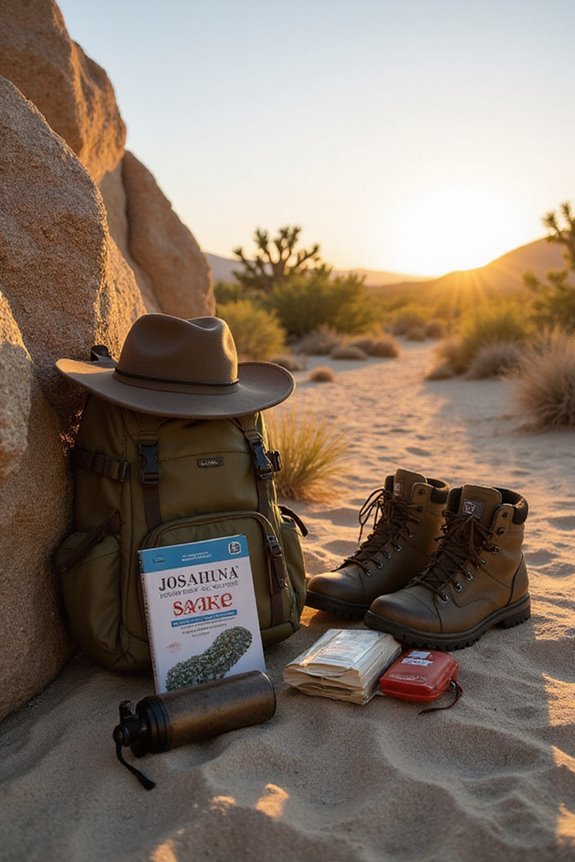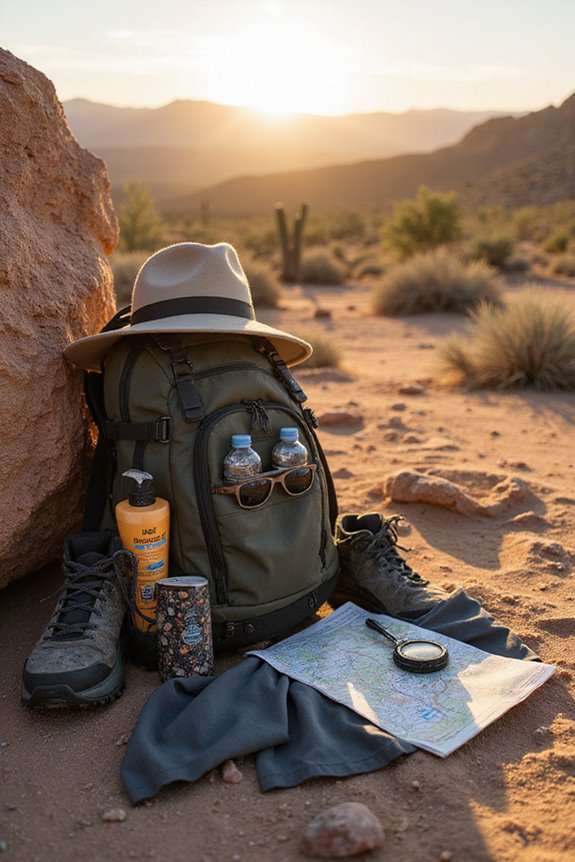When we’re out exploring the desert, wildlife safety is key! We should always stay aware of the nocturnal creatures that come alive at night to avoid the heat. Using sealed containers for food helps keep curious critters at bay. Remember to cook meat thoroughly and avoid leaving food near our sleeping areas. Let’s tread lightly, respect their homes, and keep our camps tidy. Trust me, it’s thrilling when we see wildlife from a distance! Want to know more tips?
Key Takeaways
- Store food in airtight containers away from sleeping areas to minimize wildlife attraction and encounters.
- Use non-lethal deterrents, such as noise, to keep wildlife at a safe distance.
- Choose elevated campsites to reduce the risk of flash floods and wildlife interactions.
- Be vigilant of venomous creatures and wear quick-dry pants with zippered pockets to secure food items.
- Maintain a clean cooking area and wash hands before handling food to ensure hygiene and safety.
Understanding Wildlife Behavior
When we think about desert wildlife, it’s easy to overlook the amazing adaptations that help these creatures thrive in such a harsh environment. Many of these fascinating beings embrace nocturnal activity to dodge the sweltering daytime heat, making nighttime their playground! This clever strategy not only keeps them cool but also reduces their chances of running into predators.
We can learn a lot from these species. By understanding their behaviors, like their use of burrows and shaded spots to escape the heat, we can better appreciate their resilience. Remember, if we stay aware of their predator avoidance strategies, we can enjoy observing them without becoming a part of their food chain. Let’s marvel at their ingenuity while exploring together! Always have emergency survival gear readily accessible when hiking in desert environments where wildlife encounters may occur unexpectedly.
Precautions During Camping
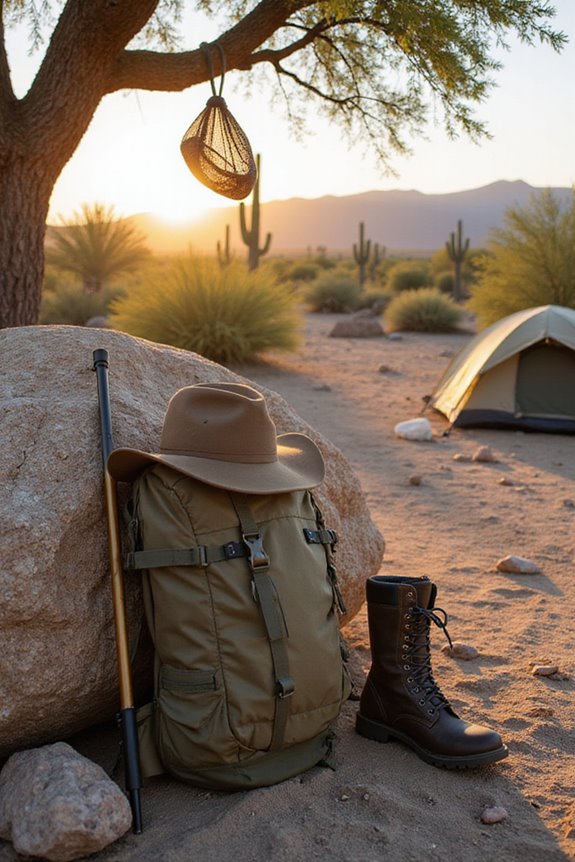
Exploring the desert is a breathtaking experience, filled with vibrant landscapes and unique wildlife. To keep our adventures safe and free from unwanted visitors, we’ve got to master a few precautions while camping. First off, let’s store our food in sealed containers or bear-proof canisters—trust me, nobody wants a coyote rummaging through their snacks! When it comes to campfire safety, keep your cooking area clean, and don’t forget to dispose of scraps responsibly. Choosing elevated campsites helps avoid flash floods and unexpected wildlife encounters. By keeping an eye out for venomous creatures and using wildlife deterrents like noise and proper food storage, we’ll relish the freedom of the desert without the uninvited guests. Always pack emergency thermal blankets that reflect body heat to maintain warmth during unexpected temperature drops in the desert night. Happy camping!
Essential Gear for Desert Exploration
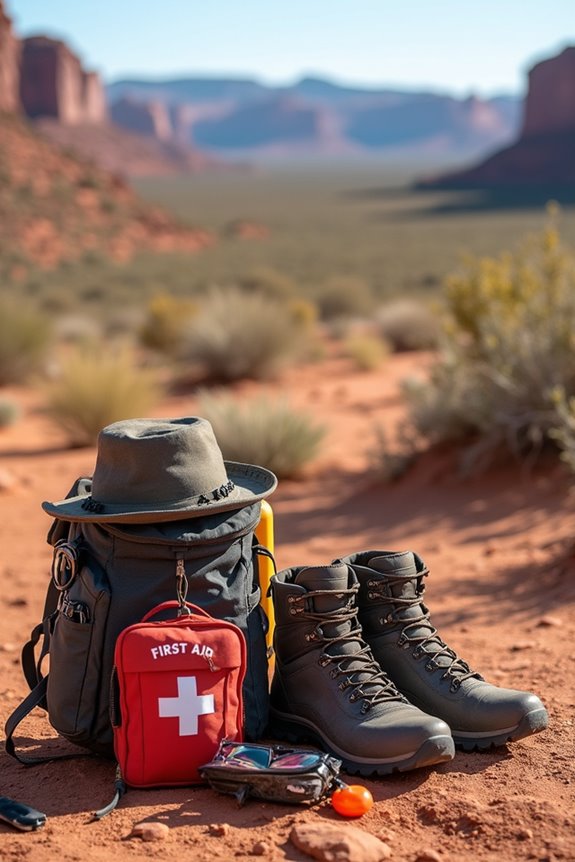
Ready to commence an unforgettable desert adventure? We’ve got to pack the right essential gear for desert exploration—it’s the key to having a blast while staying safe. Start with a waterproof jacket and some cozy fleece to ward off those chilly desert nights. Don’t forget moisture-wicking hiking pants and a trusty sun hat; we want to avoid sunburns, not tan lines!
Hydration is critical, so two water bottles are a must! And hey, let’s not underestimate the power of great footwear—comfortable boots can make all the difference on sandy trails. For optimal desert trekking, consider boots with tactical tread patterns that provide stability on loose sand and rocky terrain. Toss in polarized sunglasses, a compass, and a reliable first-aid kit. With this gear, we’re not just surviving—we’re thriving! Now, let’s hit the wild and feel that freedom!
Safe Practices Around Food
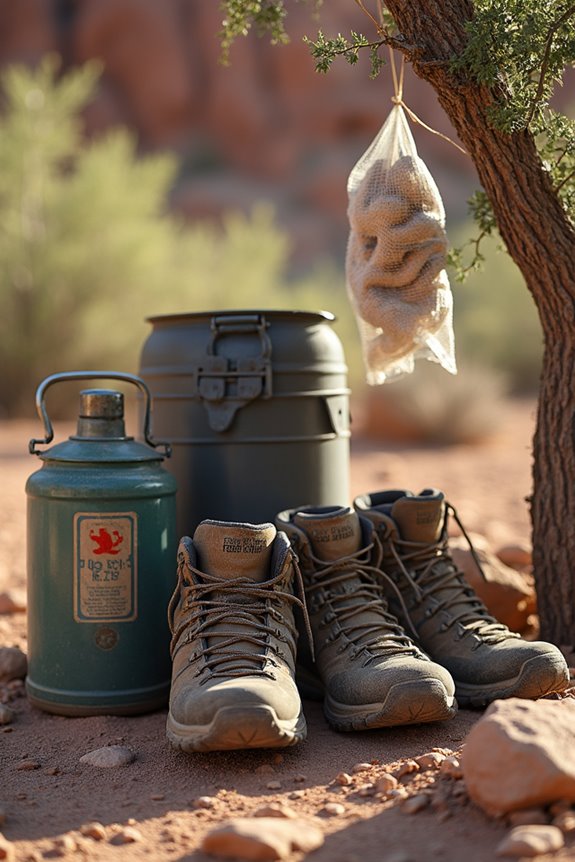
As we plunge into our desert adventure, let’s not forget that food safety is just as important as our stunning vistas! To keep wildlife at bay, we should use airtight containers for food storage and pack away all items when not in use. The desert air can spread scents like gossip, so let’s keep food sealed and store it away from our sleeping areas.
When it comes to safe cooking, we must thoroughly cook meat to avoid any unpleasant surprises. Always wash our hands before handling food; sanitation is key in the wild! Don’t forget to bring a portable water filter system that removes 99.99999% of bacteria to ensure your drinking water is safe. And remember, those tempting desert plants might not have our best interests at heart. Let’s enjoy our meals, but let’s do it the safe way for a truly unforgettable experience!
Minimizing Human-Wildlife Interactions
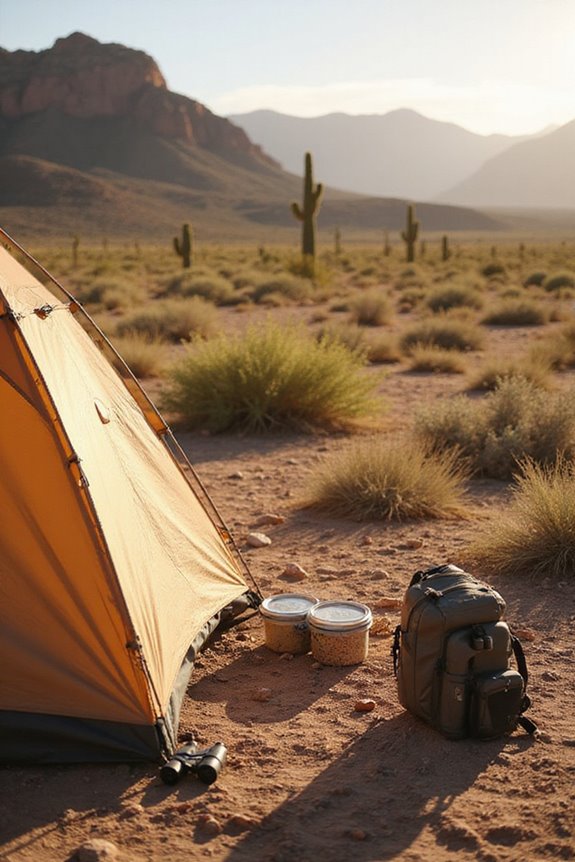
When we hit the trails in the desert, our excitement should be matched with a commitment to respecting the wildlife that calls this rugged paradise home. To minimize human-wildlife interactions, let’s pay attention to wildlife corridors. We need to tread lightly around areas where critters roam, like shaded canyons or washes, and avoid resting spots like tortoise burrows.
We can also implement non-lethal deterrents, like visual and noise devices, to encourage wildlife to keep their distance without harm. Don’t forget to secure any water sources and maintain tidy camps. Trust me, no critter wants to rummage through our leftovers! Wearing quick-dry hiking pants with zippered pockets can help secure food items and prevent wildlife attraction while providing UPF protection during desert explorations. Together, we’ll embrace the freedom of the desert while ensuring it remains a safe haven for all its inhabitants.
Frequently Asked Questions
What Should I Do if I Encounter a Wild Animal?
When we face wildlife encounters, let’s stay calm and observe the animal’s behavior. It’s essential to back away slowly, never show fear by running, and always respect their space to guarantee a safe outcome.
How Can I Identify Poisonous Snakes in the Desert?
When identifying snakes, we can focus on distinguishing venomous species through their triangular heads, slit-shaped pupils, and specific color patterns. By understanding these traits, we empower ourselves to navigate the desert more safely and confidently.
Are There Specific Times When Wildlife Is More Active?
Yes, wildlife is often more active in the early morning and late evening. If we want to enjoy the freedom of exploring the desert, let’s plan our adventures outside these peak activity times for safer encounters.
What Should I Do if Bitten by a Snake or Spider?
Did you know that about 7,000 people get bitten by snakes each year in the U.S.? If we experience a snake or spider bite, let’s stay calm, immobilize the area, and seek immediate medical help.
How Can I Help Wildlife While Camping in the Desert?
While camping, we can support wildlife conservation by practicing good camping etiquette. Let’s respect their space, store food properly, and educate each other on ways to minimize our impact on their natural habitats.

